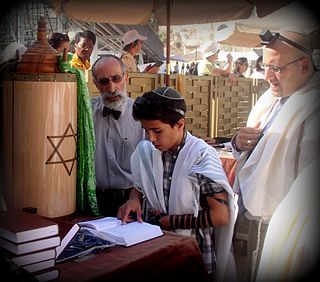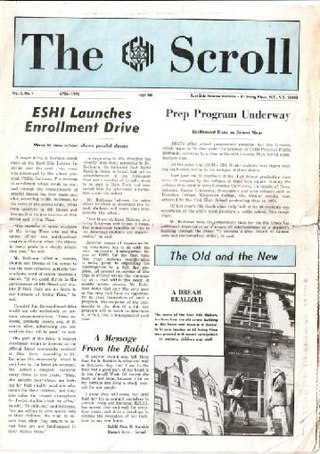Related Research Articles
Halakha, also transliterated as halacha, halakhah, and halocho, is the collective body of Jewish religious laws that are derived from the Written and Oral Torah. Halakha is based on biblical commandments (mitzvot), subsequent Talmudic and rabbinic laws, and the customs and traditions which were compiled in the many books such as the Shulchan Aruch. Halakha is often translated as "Jewish law", although a more literal translation of it might be "the way to behave" or "the way of walking". The word is derived from the root which means "to behave". Halakha not only guides religious practices and beliefs, it also guides numerous aspects of day-to-day life.

Women in Judaism have affected the course of Judaism over millenia. Their role is reflected in the Hebrew Bible, the Oral Law, by custom, and by cultural factors. Although the Hebrew Bible and rabbinic literature present various female role models, religious law treats women in specific ways. According to a 2017 study by the Pew Research Center, women account for 52% of the worldwide Jewish population.

A bar mitzvah (masc.) or bat mitzvah (fem.) is a coming-of-age ritual in Judaism. According to Jewish law, before children reach a certain age, the parents are responsible for their child's actions. Once Jewish children reach that age, they are said to "become" b'nai mitzvah, at which point they begin to be held accountable for their own actions. Traditionally, the father of a bar or bat mitzvah offers thanks to God that he is no longer punished for his child's sins.

Torah study is the study of the Torah, Hebrew Bible, Talmud, responsa, rabbinic literature, and similar works, all of which are Judaism's religious texts. According to Rabbinic Judaism, the study is done for the purpose of the mitzvah ("commandment") of Torah study itself.
In its primary meaning, the Hebrew word mitzvah refers to a commandment from God to be performed as a religious duty. Jewish law in large part consists of discussion of these commandments. According to religious tradition, there are 613 such commandments.

A cheder is a traditional primary school teaching the basics of Judaism and the Hebrew language.
A seudat mitzvah, in Judaism, is an obligatory festive meal, usually referring to the celebratory meal following the fulfillment of a mitzvah (commandment), such as a bar mitzvah, bat mitzvah, a wedding, a brit milah, or a siyum. Seudot fixed in the calendar are also considered seudot mitzvah, but many have their own, more commonly used names.
Bereavement in Judaism is a combination of minhag (traditions) and mitzvah (commandments) derived from the Torah and Judaism's classical rabbinic literature. The details of observance and practice vary according to each Jewish community.

Torah Umesorah – National Society for Hebrew Day Schools is an Orthodox Jewish educational charity based in the United States that promotes Torah-based Jewish religious education in North America by supporting and developing a loosely affiliated network independent private Jewish day schools.
A Jewish day school is a modern Jewish educational institution that is designed to provide children of Jewish parents with both a Jewish and a secular education in one school on a full-time basis. The term "day school" is used to differentiate schools attended during the day from part time weekend schools as well as secular or religious "boarding school" equivalents where the students live full-time as well as study. The substance of the "Jewish" component varies from school to school, community to community, and usually depends on the Jewish denominations of the schools' founders. While some schools may stress Judaism and Torah study others may focus more on Jewish history, Hebrew language, Yiddish language, secular Jewish culture, and Zionism.

Jewish education is the transmission of the tenets, principles, and religious laws of Judaism. Jews value education, and the value of education is strongly embedded in Jewish culture. Judaism places a heavy emphasis on Torah study, from the early days of studying the Tanakh.

The East Side Hebrew Institute was a traditional Jewish day school, in the East Village/Alphabet City area of Manhattan, New York City. It was "once one of the major institutions of the Jewish East Side".
Rabbi Goldie Milgram is an American rabbi, educator, and writer. She is best known as the "rebbe-on-the-road," for her travels worldwide as a seeker and teacher of Torah, Jewish spiritual practices and she is a specialist in the fields of Jewish experiential and spiritual education. "Reb Goldie" founded (2000) and heads the 501C3 non-profit Reclaiming Judaism, serves as editor-in-chief for Reclaiming Judaism Press, and in 2014 she founded a three-year distance-learned training program for Jewish educators titled Jewish Spiritual Education (JSE): Maggid-Educator Training.
Mesivta is an Orthodox Jewish yeshiva secondary school for boys. The term is commonly used in the United States to describe a yeshiva that emphasizes Talmudic studies for boys in grades 9 through 11 or 12; alternately, it refers to the religious studies track in a yeshiva high school that offers both religious and secular studies.
An aliyah is the calling of a member of a Jewish congregation up to the bimah for a segment of the formal Torah reading. A person receiving an aliyah is called an oleh (male) or olah (female).
Lesbian, gay, bisexual, transgender (LGBT) affirming denominations in Judaism are Jewish religious groups that welcome LGBT members and do not consider homosexuality to be a sin. They include both entire Jewish denominations, as well as individual synagogues. Some are composed mainly of non-LGBT members and also have specific programs to welcome LGBT people, while others are composed mainly of LGBT members.

Beth Shalom Reform Synagogue is a synagogue in the City of Cambridge. Founded in 1981, it held services in hired premises until 2015 when the community opened a new synagogue on a site on Auckland Road, the first Reform synagogue in Cambridge. The new building includes a prayer hall for at least 200 people. The building was dedicated on 6 September 2015 at a service led by Fiona Karet Frankl and addressed by Rabbi Laura Janner-Klausner, senior rabbi to the Movement for Reform Judaism.
Or Emet, officially the Minnesota Congregation for Humanistic Judaism, is a Humanistic Jewish synagogue and congregation in Minneapolis – Saint Paul, Minnesota, in the United States. The congregation is a member of the Society for Humanistic Judaism. It is a community of cultural Jews, secular Jews, Jewish humanists, and other humanists, united by a commitment to humanism and by respect and support for Jewish culture, traditions, and Jewish identity, and by those traditional Jewish values most consonant with humanism — tikkun olam, social justice. Or Emet embraces a human-centered philosophy that combines rational thinking and scientific inquiry with the celebration of Jewish culture and traditions.
An adult bar/bat mitzvah is a bar or bat mitzvah of a person older than the customary age. Traditionally, a bar or bat mitzvah occurs at age 13 for boys and 12 for girls. Many adult Jews who have never had a bar or bat mitzvah, however, may choose to have one later in life, and many who have had one at the traditional age choose to have a second. An adult bar or bat mitzvah can be held at any age after adulthood is reached and can be performed in a variety of ways.

Judith Eisenstein was an author, musicologist, composer, theologian and the first person to celebrate a bat mitzvah publicly in America.
References
- 1 2 3 Abrahams, Israel and Claude Goldsmid Montefiore, ed. (1900). "The Jewish Sunday School Movement in the United States". The Jewish Quarterly Review. 12. New York: MacMillan Company.
- ↑ "Rebecca Gratz".
- ↑ "Temple Emanu-El".
- ↑ "NSHS Hebrew School for Children Grades K - 6". Archived from the original on 3 November 2006. Retrieved 9 September 2009.
- ↑ "Curriculum". Archived from the original on 19 May 2009. Retrieved 9 September 2009.
- ↑ Carol K. Ingall (1993). Bar/Bat Mitzvah: Policies and Programs. Denver: A.R.E Publishing, Inc. ISBN 9780867050318.
{{cite book}}:|work=ignored (help) - ↑ "Eicha". 23 July 2007.